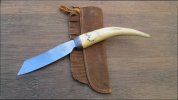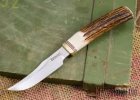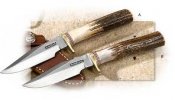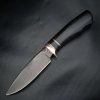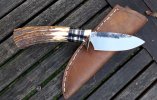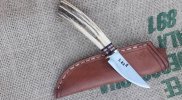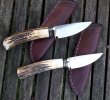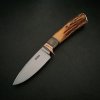- Joined
- Dec 1, 2016
- Messages
- 10,368
We are probably at a point in this conversation where we should define some hard characteristics (i.e. blade size, grind, shape; handle style; overall length; etc.).
As I mentioned earlier in the thread, it is challenging to pinpoint a precise example of a "patch knife". A study was done on a large selection of surviving examples of hunting bags from the period in question (1780s-1830s, give or take) and it was noted that many had sheaths built in for small knives but many of them also did not. This has led to some believing that though it is without question that small utilitarian blades were in common supply, it is just as probable that individuals would use whatever blade they had on hand, even large ones, to trim their patches.
For the purpose of this conversation, I would say that a patch knife is nothing more than a small blade that was used for just about everything short of shanking a bear. Some have insisted that a patch knife has to be chisel ground or at the very least, full flat ground, in order to properly trim the cloth away from the muzzle of your rifle. I'm not thinking that is entirely necessary.
In my mind, a patch style knife would make for a small, yet utilitarian, everyday knife - carried in the pocket or on a small belt sheath. Slim in overall design, with a blade length that doesn't exceed 3.5" - 4". I am picturing Stag rounds or crown with little or no guard and a tidy selection of stacked materials that Scott does so well in implementing.
As I mentioned earlier in the thread, it is challenging to pinpoint a precise example of a "patch knife". A study was done on a large selection of surviving examples of hunting bags from the period in question (1780s-1830s, give or take) and it was noted that many had sheaths built in for small knives but many of them also did not. This has led to some believing that though it is without question that small utilitarian blades were in common supply, it is just as probable that individuals would use whatever blade they had on hand, even large ones, to trim their patches.
For the purpose of this conversation, I would say that a patch knife is nothing more than a small blade that was used for just about everything short of shanking a bear. Some have insisted that a patch knife has to be chisel ground or at the very least, full flat ground, in order to properly trim the cloth away from the muzzle of your rifle. I'm not thinking that is entirely necessary.
In my mind, a patch style knife would make for a small, yet utilitarian, everyday knife - carried in the pocket or on a small belt sheath. Slim in overall design, with a blade length that doesn't exceed 3.5" - 4". I am picturing Stag rounds or crown with little or no guard and a tidy selection of stacked materials that Scott does so well in implementing.


